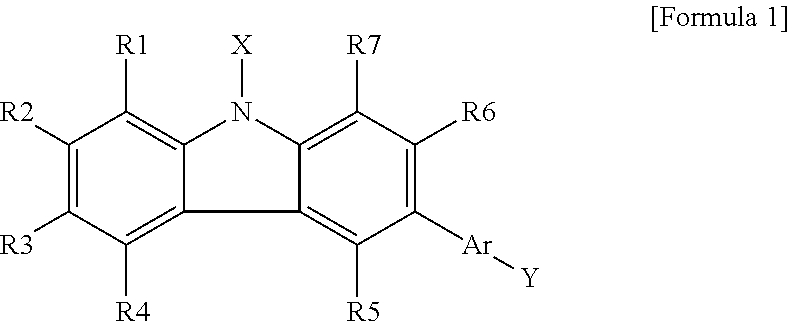New compound and organic light emitting device using the same
a light-emitting device and compound technology, applied in the field of organic light-emitting devices, can solve the problems of difficult to produce organic light-emitting devices with high efficiency and a long lifespan, and difficult to apply to organic light-emitting devices requiring high current, so as to improve the life span of the device, reduce the driving voltage of the device, and improve the effect of light efficiency
- Summary
- Abstract
- Description
- Claims
- Application Information
AI Technical Summary
Benefits of technology
Problems solved by technology
Method used
Image
Examples
preparation example 1
Manufacturing of the Compound Represented by Formula 4
[0051]
preparation example 1-1
Manufacturing of the Compound A
[0052]After 2-bromothiopene (20 g, 122.7 mmol) and phenyl boronic acid (18 g, 147.6 mmol) were dissolved in tetrahydrofuran (300 ml), 4N potassium carbonate aqueous solution (130 mL) and tetrakis(triphenylphosphine)palladium (0) (2.9 g, 2.5 mmol) and were put thereinto and heated while being agitated. After the reaction was finished, the organic layer was separated and dried by using anhydrous magnesium sulfate. After it was distilled under the reduced pressure, it was recrystallized by using hexane to obtain a compound A (14.6 g, yield 74%; [M+H]+=161).
preparation example 1-2
Manufacturing of the Compound B
[0053]The compound A (18 g, 112.3 mmol) that was manufactured in Preparation Example 1-1 was dissolved in anhydrous tetrahydrofuran, n-butyl lithium (2.5M hexane solution, 49.4 mL, 123.5 mmol) was added dropwise at −78° C., and agitated for 1 hour. Trimethyl borate (15.1 g, 145.3 mmol) was put thereinto, agitated for 1 hour, 2N hydrochloric acid aqueous solution (80 mL) was put thereinto, and it was heated to normal temperature. After the organic layer was separated, it was dried by using anhydrous magnesium sulfate. After it was distilled under the reduced pressure, it was recrystallized by using hexane to obtain a compound B (15.2 g, yield 66%; [M+H]+=205).
PUM
| Property | Measurement | Unit |
|---|---|---|
| glass transition temperature | aaaaa | aaaaa |
| current density | aaaaa | aaaaa |
| current density | aaaaa | aaaaa |
Abstract
Description
Claims
Application Information
 Login to View More
Login to View More - R&D
- Intellectual Property
- Life Sciences
- Materials
- Tech Scout
- Unparalleled Data Quality
- Higher Quality Content
- 60% Fewer Hallucinations
Browse by: Latest US Patents, China's latest patents, Technical Efficacy Thesaurus, Application Domain, Technology Topic, Popular Technical Reports.
© 2025 PatSnap. All rights reserved.Legal|Privacy policy|Modern Slavery Act Transparency Statement|Sitemap|About US| Contact US: help@patsnap.com



